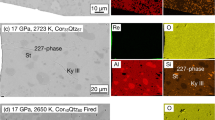Abstract
The stability relations of phase egg, AlSiO3(OH), have been investigated at pressures from 7 to 20 GPa, and temperatures from 900 to 1700 °C in a multi-anvil apparatus. At the lower pressures phase egg breaks down according to the univariant reaction, phase egg = stishovite + topaz-OH, which extends from 1100 °C at 11 GPa to 1400 °C at 13 GPa where it terminates at an invariant point involving corundum. At pressures above the invariant point, the stability of phase egg is limited by the breakdown reaction, phase egg = stishovite + corundum + fluid, which extends from the invariant point to 1700 °C at 20 GPa. Stishovite crystallized in the Al2O3-SiO2-H2O system contains Al2O3, and the amount of Al2O3 increases with increasing temperature. It is inferred that the Al2O3 content is controlled by the charge-balanced substitution of Si4+ by Al3+ and H+. Aluminum-bearing stishovite coexisting with an H2O-rich fluid may contain a certain amount of water. Therefore, phase egg and stishovite in a subducting slab could transport some H2O into the deep Earth.
Similar content being viewed by others
Author information
Authors and Affiliations
Additional information
Received: 14 October 1998 / Accepted: 19 May 1999
Rights and permissions
About this article
Cite this article
Ono, S. High temperature stability limit of phase egg, AlSiO3(OH). Contrib Mineral Petrol 137, 83–89 (1999). https://doi.org/10.1007/s004100050583
Issue Date:
DOI: https://doi.org/10.1007/s004100050583




